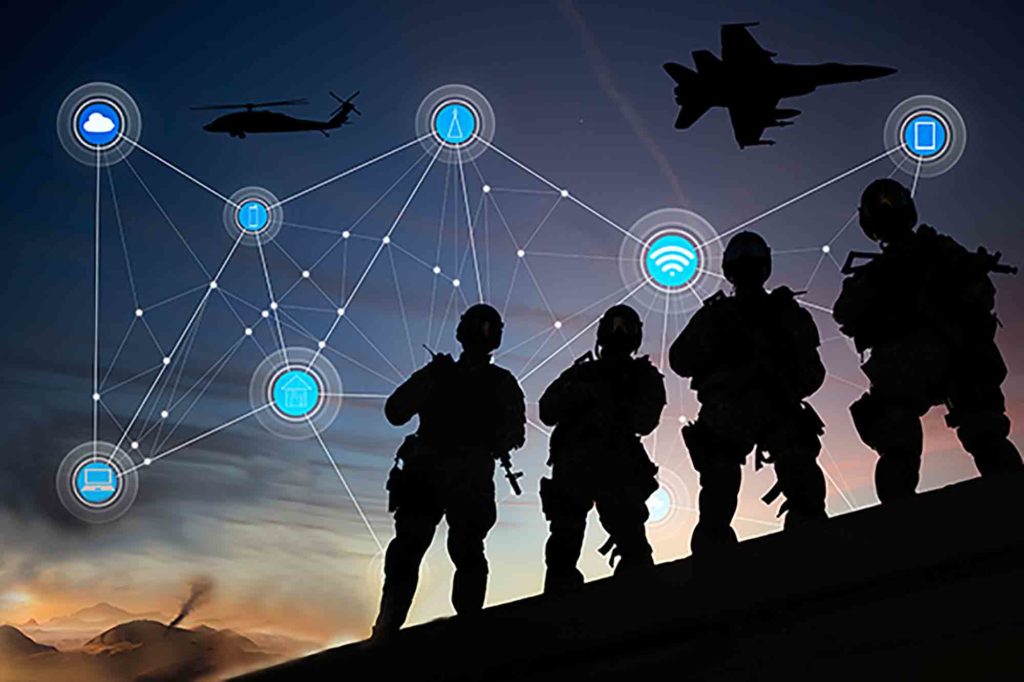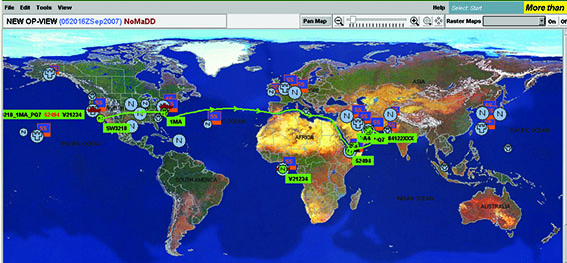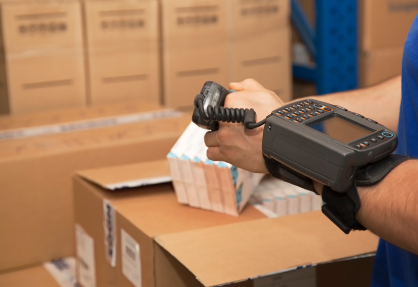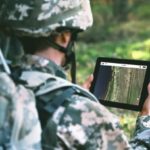Decades ago, the U.S. Department of Defense (DoD) played a critical role in laying the foundation for the Internet of Things (IoT) with sensors, extensive computer networks and communications technologies. Today, as the IoT transforms the world around us – from smart homes to smart factories – leveraging the IoT for the defense supply chain seems like the logical next step in the military’s digital transformation. But it’s not that simple.

Over the years, the U.S. military has focused its IoT-related deployments on combat operations, primarily network-centric warfare – the centerpiece of military transformation that relies on sensors, platforms and networks for battlefield situational awareness. The DoD also continues to drive innovation with machine-to-machine communications and artificial intelligence.
In the area of asset management, the military uses radio frequency identification (RFID) tags to track shipments and manage inventories, but RFID sensors are just part of the IoT equation.
The IoT Elephant in the Room: CONNECTIVITY
The IoT has become a ubiquitous term with all the hype surrounding sensors and smart devices in the private sector. The Internet of Things actually involves much more than a network of sensors and smart devices collecting data. The ultimate challenge is connecting these technologies as part of an intelligent network, and transforming “Big Data” into meaningful information. Connectivity, therefore, is key to a true IoT infrastructure.
IoT systems are more than just sensors collecting massive amounts of data. To be a true IoT system, the data must undergo analysis and be used to effect some type of physical or virtual response,” as noted in the CSIS report, Leveraging the Internet of Things for a More Efficient and Effective Military.
A major challenge is that information is often collected from sensors that are not designed to  communicate with one another, and this poses a major problem in managing supply chain assets. Rather than extracting data from each sensor type, a true IoT platform fuses the data from multiple sensors in real time, providing timely, actionable information to decision makers.
communicate with one another, and this poses a major problem in managing supply chain assets. Rather than extracting data from each sensor type, a true IoT platform fuses the data from multiple sensors in real time, providing timely, actionable information to decision makers.
In the commercial sector, the IoT is transforming everything from manufacturing and supply chains to transportation systems and maintenance management systems. It is significantly improving productivity, efficiency and profitability. However, the military has not kept pace with commercial IoT deployments for several reasons, including security concerns, shrinking budgets and interoperability challenges.
While the military has been a driver in connected and machine-to-machine communications such as radio frequency identification, more commonly known as RFID, it has been slow to adopt true IoT applications that knit these communications into interoperable, automated cycles. Communications remain within their given channels, not easily shared or aggregated,” according to the Deloitte article, Continuing the march: The past, present, and future of the IoT in the military.
With this in mind, broader deployment of IoT technology across the military “requires investment in increased connectivity, digital analytics and improved interoperability,” noted to CSIS authors Denise E. Zheng and William A. Carter.
ESI: Solving the Interoperability Challenge
Tapestry Solutions provides the gateway to the IoT with its Enterprise Sensor Integration (ESI) technology. ESI effectively bridges disparate sensors together via a single interface, solving challenges related to interoperability. It also delivers automation, real-time alerts, mapping applications and analytics – the full offerings of the Internet of Things. This ensures total asset visibility of equipment, tools, cargo and processes anywhere and at any time.

In fact, Boeing – the world’s largest aerospace company – has already reaped the rewards of ESI. At Boeing, ESI has integrated its asset tracking and supply chain management systems on a common platform across 50 assembly plants. This unity of information, powered by sensor integration, saved Boeing more than $100 million in the first year alone, and it continues to generate huge savings each year.
The ESI platform integrates sensors ranging from RFID position-information tags, passive and active GPS-enabled WiFi tags to embedded hardware and complex servers. ESI also seamlessly integrates customers’ legacy and next generation systems. As a “sensor agnostic” solution, ESI can communicate with many different hardware and software vendors’ IoT solutions. The platform can be implemented across a global enterprise, either in the cloud or on dedicated servers.
With sensor fusion as a core capability, Tapestry Solutions has been delivering enterprise-level solutions to commercial and military customers for decades. Let’s take a closer look at Tapestry’s asset management solutions of the past and how these technologies eventually led to the development of solutions like ESI.
BCS3: A New Age in Information Sharing
Dating back to the U.S.-Iraq War, Tapestry Solutions developed the Army’s Battle Command Sustainment Support System (BCS3) in response to mounting pressure for better asset tracking. First fielded in 2004, BCS3 represented the start of a new age in sustainment information sharing. BCS3 was among the first battle command  systems for logistics that helped commanders filter critical logistics information.
systems for logistics that helped commanders filter critical logistics information.
Still in limited use today, BCS3 provided commanders with a joint logistics common operating picture. It tied together information from numerous, disparate Army logistics systems, in-transit visibility systems, and other fragmented data sources. This enabled operators to view the supply stockage levels in warehouses and track the movement of supplies as they traveled through the distribution systems via air, land and sea.
Among the subsystems feeding into BCS3 were RFID tags and fixed-site interrogators. BCS3 processed RFID tag data and graphically depicted the data on a map or report (shown above).
The RFID tags work like “wireless bar codes” that record, track, and manage the supplies and equipment of a modern networked military, according to the article, “RFID Technology: Keeping Track of DoD’s Stuff.” There are many benefits to RFID, including improved asset tracking, inventory management and automation. However, the DoD had faced challenges of achieving widespread RFID implementation, mainly because it was unable to demonstrate the return on investment.
Improving the Effectiveness of RFID – and Multiple Sensor Technologies
Fast forward to today. As the costs of using RFID technology decreased phenomenally, RFID has been deployed across military supplies and assets, including aircraft, tanks, weapons and ammunition, soldiers and equipment.
 It is estimated that the military has over 3 million active RFID tags in circulation, including over 3,000 tag-reader devices in Afghanistan, Iraq, Kuwait and Pakistan, according to ToolHound, a developer of web-based tool management software. RFID is often used with barcodes to record, track and manage military equipment and supplies.
It is estimated that the military has over 3 million active RFID tags in circulation, including over 3,000 tag-reader devices in Afghanistan, Iraq, Kuwait and Pakistan, according to ToolHound, a developer of web-based tool management software. RFID is often used with barcodes to record, track and manage military equipment and supplies.
The information collected by RFID tags is significant, but its value is limited if the data remains siloed, or isolated from other data sources. Its true potential can only be realized when connected to other sensors and asset management systems via an Internet of Things platform, like Tapestry’s ESI.

By fusing data from multiple sensor technologies from multiple vendors, ESI gives decision-makers a complete picture of their asset movements and inventory. For instance, if an enemy mobilized against the U.S., military officers can immediately identify what is happening, determine which assets are nearby, mobilize those assets and ensure they have enough equipment, supplies, and soldiers to overcome the opposition.
Despite the challenges of adopting IoT for military applications, ESI can help defense organizations leverage this interconnected architecture to increase efficiency, reduce costs and enhance situational awareness across the full spectrum of defense logistics management.
It’s all about information-sharing – and achieving information superiority in the battlespace – because military commanders have always lived and died by information.
he appearance of U.S. Department of Defense (DoD) visual information
does not imply or constitute DoD endorsement.
Contact:
Janet Dayton
Tapestry Solutions Inc.
jdayton@tapestrysolutions.com
Watch ESI Commercial to Learn More






